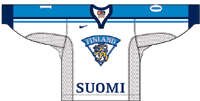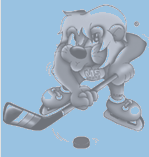HISTORY
The beginnings of hockey in this Scandinavian country have been much researched by archivists. The first hockey players appeared in Balt in Pohjoisranta in 1899. It took almost another three decades before the Finnish Skating Association was inclined to accept a new sport into its ranks, in 1927, but by this time any concerns or doubts were finally laid to rest. Less than a year later, on 15 January 1928, the first official club match was played between the clubs Pyrintö and Palloilijat. In that same year, the Finns lost their first international game with Sweden 8-1 but also became members of the International Ice Hockey Federation (IIHF).
It was at this time felt necessary to set up a domestic hockey federation – and one was formed on 20 January 1929 with seventeen member clubs. The first official champion was the Helsinki club HJK. Players from the “country of a thousand lakes” improved over the years but it was still not enough to take them up to the level of the world’s top teams. In 1933, the Finnish national team set off for the first time to play outside of its own borders, but suffered an 11-1 defeat at the hands of Sweden. The Finns had to wait for their first victory in an international match until 1937 when they beat Estonia 2-1. Two years later Finnish hockey representatives were self-confident enough to register their champions for the World Championship for the first time. But in Basle, Switzerland in 1939, Finland lost all five of its matches and ended up thirteenth.
In the end, the Finns had to wait for their first winning streak after a lot of effort and hard work. It was as if they wanted to give the Finnish Ice Hockey Federation a twentieth-birthday gift – in 1949 they beat Norway 7-3 and Belgium 17-2. Three years later Finland finished seventh at the Oslo Winter Olympic Games and development then proceeded rapidly. In 1954, the Finns played the Soviet Union for the first time in history. In another year a winter stadium of very high quality was opened in Tampere and as a result the player base began to grow.
A whole sixty years after the first Finn stood on skates and took a stick in his hands, the country was still awaiting its first victory over Sweden. In 1962 the “blue and whites” won their first European medal and in three years they were considered such a well-established member of the International Ice Hockey Federation that they were given the chance to organize the World Championship for the first time. And it seems like future Finnish hockey players came to watch that tournament in Tampere and learned a lot from their idols – for in 1974 Finland won silver medals at the World Junior Championship and the rest of the world began to really take Finland seriously. Even the NHL began to take notice of the Finns. Matti Hagman, chosen by the Boston Bruins went overseas as the first Finn and as the one of the very first Europeans.
Successes began to come more and more often – Jari Kurri, the future Edmonton Oilers star, scored in overtime to secure the first significant gold medal for Finland – the European U18 Championship. The defensemen Pekka Rautakalio played in the NHL All-star Game and in 1987, the Finns became World Champions for the first time – the then Czechoslovakia saw them triumph at the World Juniors when the Soviet Union and Canada were disqualified for an on-ice brawl! Finland only had to wait a year later for their first Olympic medal – a snow-flake shaped silver in Calgary. The final significant medal eluding the Finns was one from the World Championship. The Fighting Finns wait came to an end in 1992 in Prague. Even though they lost in the final to Sweden, only three years later they returned the favour to their greatest rival – in Stockholm’s Globen arena they beat Sweden 4-1 in the final and launched hysteria across hockey-mad Finland. The hockey world realizes it must seriously watch the Finns, as closely as it has already watched its northern neighbour Sweden. In 1997, the Finnish under-eighteen team won the first World Championship, and a year later the under-twenty national team had gold medals hung around their necks, and Suomi youth teams were not missing from the medal podiums in other years either.
The last senior World Championship did not turn out well for the Finns though – they lost at home in the key quarter-final battle with Sweden 6-5 even though they had been leading 5-1! The disappointment of fans was even greater due to the fact that none of the big stars of Finnish hockey that were free for the tournament, was missing from the team. But the future looks bright…

WEB SITE
www.sm-liiga.fi (Finnish League)
www.finhockey.fi (Official pages of Finish Ice Hockey Federation)
STATS
You can find the results and the calendar of 2003/04 season HERE
MEDALS
World Championship
Gold: once – 1995.
Silver: 5 times – 1992, 1994, 1998, 1999, 2001.
Bronze: once – 2000.
Olympic Games
Gold: –
Silver: once – 1988 (Calgary).
Bronze: 2 times – 1994 (Lillehammer), 1998 (Nagano)
PLAYERS
Top stars: Jari Kurri, Esa Tikanen, Lasse Oksanen, Matti Hagman, Pekka Rautakalio, Ilpo Koskela, Pekka Marjamäki, Jorma Valtonen, Urpo Ylönen, Veli-Pekka Ketola.
Best NHL players, 2002-2003:
Saku Koivu (Montreal Canadiens – 82 games, 21 goals, 50 assists).
Olli Jokinen (Florida Panthers – 81 games, 36 + 29).
Teemu Selänne (San Jose Sharks – 82 games, 28 + 36) .
World Champions 1995 – Stockholm
Goalies: Jarmo Myllys, Ari Sulander, Jukka Tammi.
Defense: Timo Jutila, Mika Strömberg, Janne Niinimaa, Marko Kiprusoff, Hannu Virta, Petteri Nummelin, Erik Hämäläinen.
Forwards: Ville Peltonen, Saku Koivu, Raimo Helminen, Mika Nieminen, Jere Lehtinen, Esa Keskinen, Sami Kapanen, Juha Ylönen, Janne Ojanen, Raimo Summanen, Tero Lehterä, Marko Palo, Antti Törmänen.
Head Coach: Curt Lindström.
HOW THEY ARE SEEN BY…
Martin Štěpánek, 2000 World Champion, former player for Lukko Rauma and IFK Helsinki: “The Finns have a hockey style that is based on pure simplicity, and it is said that they are good skaters. It is possible to say as well, a little bit tongue-in-cheek, that while in the Czech Republic it’s mainly the puck that flies down the ice, in Finland it’s more likely to be the players. But where the Finns really excel is with their work in the corners of the rink. For instance, they really know how to control an opponent there. They practice a lot of two on ones and three on twos, and they are very good at this. The Finnish League is of a high quality, there is no doubt about it. And what are some of the most popular clubs? Probably Jokerit Helsinki but it is the same as in the Czech Republic with Sparta Prague. When Jokerit goees to any little city their life there is not so comfortable. The fans in Finland are a little bit colder than in the Czech Republic but they definitely enjoy their hockey.”








